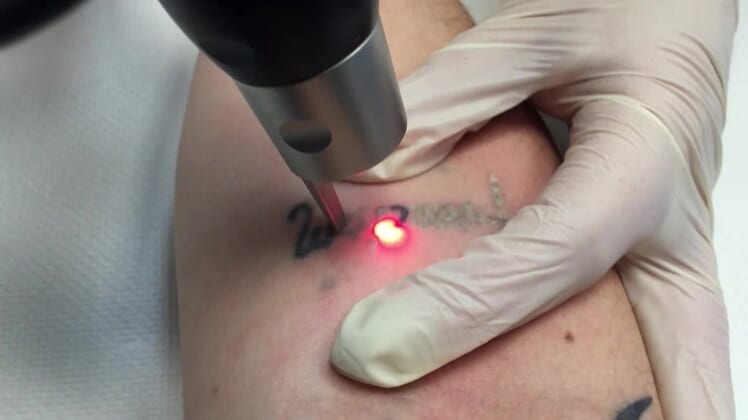
[bc_video video_id=”5483771989001″ account_id=”5374160583001″ player_id=”HJtnW6IQW”]
Revenue from tattoo removals has increased 440% over the last decade. Barbed wire arm bands and Zelda tattoos, popular in the 90s, don’t seem as relevant as they did 20 years ago. And there will always be post-breakup name removals, tattoos that stand out too much at work, and botched tattoo jobs that are removed almost as soon as they’re healed.
According to a 2006 study, about a fifth of people who have tattoos are unhappy with them, but only 6% seek removal. Some reasons given were “they were tired of it,” “they just grew up,” and “it was embarrassing them.”
Part of this regret can be explained by something called the end-of-history illusion. This refers to the fact that even though we know our tastes and values have changed significantly in the past, we fail to understand that they’ll probably continue to change in the future. In other words, many of us are stuck with the false idea that we’re a finished product. If you’re sure that you’ll still be crazy about Pokémon 50 years from now, that Pikachu tattoo makes sense. But not so much if you think your tastes may evolve.
How to Remove a Tattoo
There are over-the-counter creams that claim to speed up the fading process of tattoos, but they’re generally considered ineffective. And some products have the potential to cause burns or other reactions. The most popular method for tattoo removal is the use of lasers to break up pigments under the skin using high intensity light beams. Laser tattoo removal is generally considered safe and is very effective for some people.
There are quite a few things to keep in mind when deciding whether or not to go for laser removal. First, it’s most effective on cheap, low quality tattoos. High-end tattoo artists use expensive, difficult-to-remove inks that are more deeply embedded in the skin. And of course, the smaller the tattoo, the less hassle to remove. A large surface area makes for longer and more painful treatment sessions with the laser.
Another factor to consider is what color inks you chose for your design. Different types of lasers target different ink colors, and most doctors have a laser that targets blue and black inks since those colors are by far the most common. If you have a lot of red ink in your tattoos, you may want to look around for someone who also has a laser that targets red ink for the best results.
The process doesn’t usually take long, but it can be a little painful. Some patients use something to numb their skin before their appointment, but it’s important to check with the doctor who will be doing the removal to make sure a numbing cream won’t interfere with the process.
Mixed Results
Unfortunately, laser tattoo removal isn’t always effective after the first, second, or even third session. Skin type and the type of tattoo both seem to play a role in effectiveness. Tattoos can be more difficult to remove from darker skin because the laser can attack the skin’s pigment as well as the tattoo pigments if the procedure isn’t done carefully. Your tattoo should become lighter after each pass with the laser, but it can take many treatments over a period of years for some tattoos to disappear completely. And treatments can be expensive, so make sure you’re prepared for multiple treatment sessions when you’re comparing prices and budgeting for the procedure.
An exciting new development you should ask about is the DeScribe patch. It speeds up ink removal for many patients and was designed to decrease the number of overall treatments needed to completely fade a tattoo. A 2015 clinical study showed that it increased ink clearance for more than half of patients with no side effects.
If you’re considering tattoo removal, find a reputable dermatologist or cosmetic surgeon for the best results.
